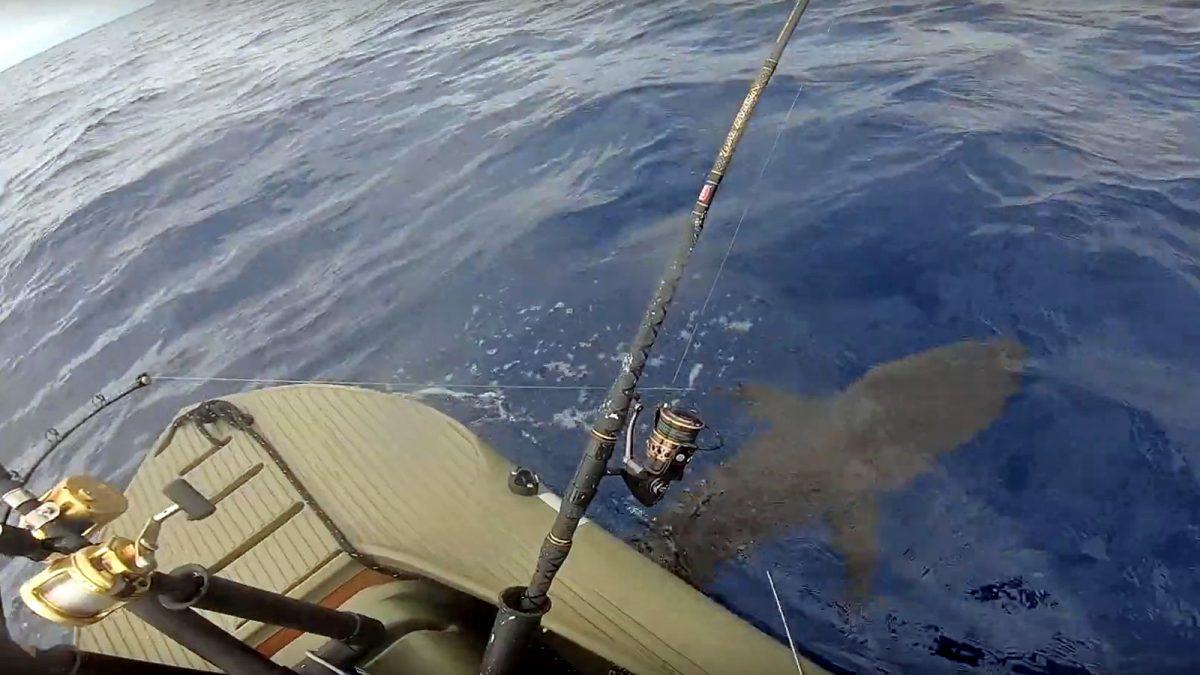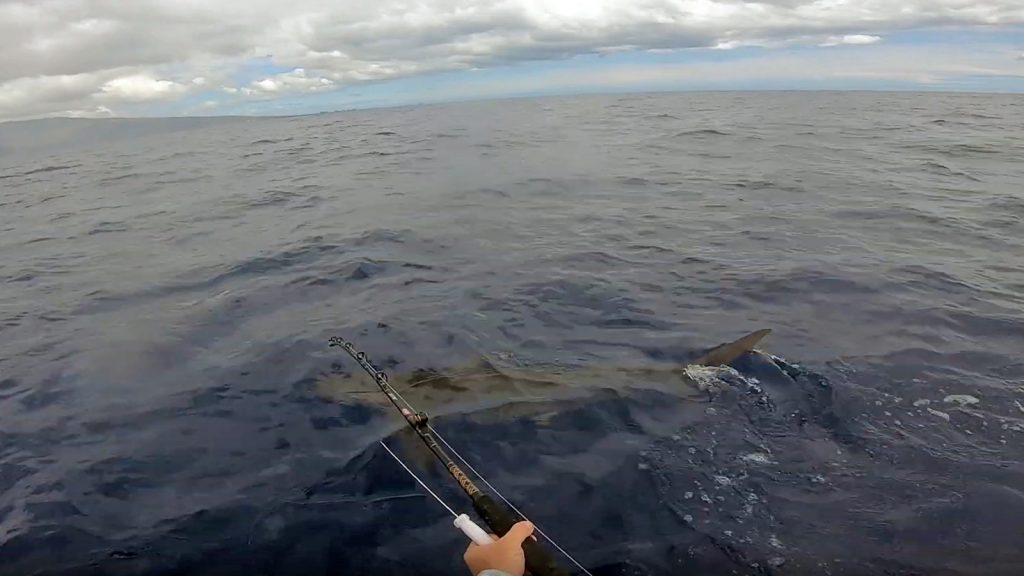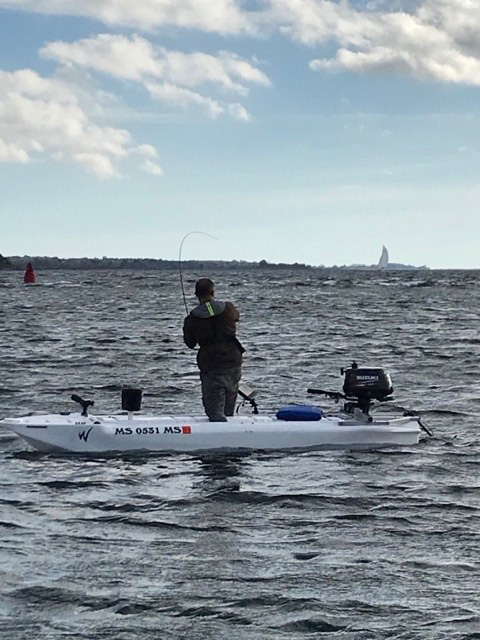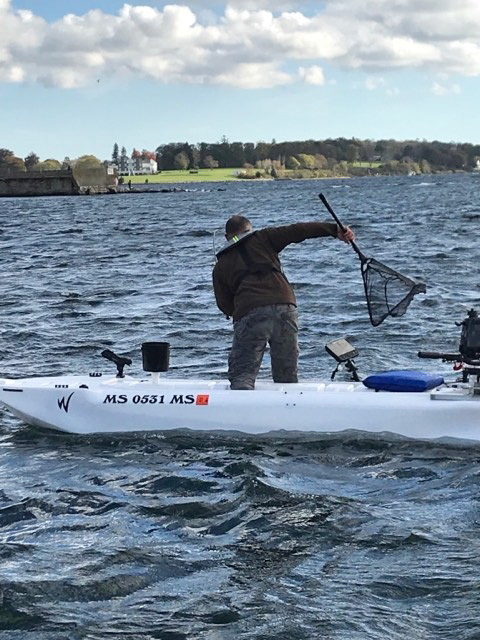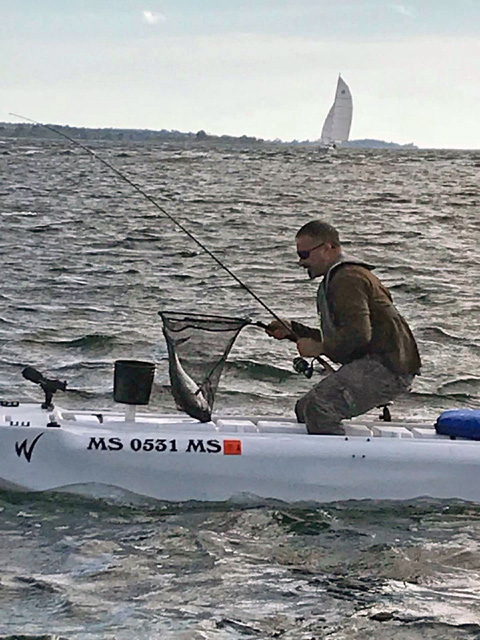Fishing in the Ocean
The ocean offers great fishing opportunities, but it presents special challenges and hazards to kayak anglers, and to anglers who fish out of small boats, such as microskiffs. Fishing out of a kayak in the ocean requires a stable, high performance kayak such as the W700 or W720, or better – a seaworthy boat such as the Wavewalk S4 microskiff.
Mike Silva from Massachusetts fishing for Albacore Tuna in Cape Cod (click images to enlarge)
Motorizing your ocean fishing kayak
A motorized fishing kayak is safer to use in the ocean since it offers the angler a chance to deal with strong wind, waves, fast currents, and the long distances they may need to go in order to return safely to their launching spot, or to shore. Although motorized kayaks are typically heavier than non-motorized ones, driving a motorized kayak is certainly easier than paddling a non-motorized one. This is especially true after a long day of fishing and paddling, when the angler is tired, and it’s even more relevant for middle aged and elderly anglers. Simply put, a non-motorized fishing kayak is hazardous to fish from in the ocean.
As far as deciding between an electric motor and an outboard gas engine, the former is not suited for use in the ocean, and the latter is pretty much impossible to use with any type of fishing kayak except the W700 that can take an outboard gas motor up to 3 HP.
You may be interested to read more about the advantages and disadvantages of electric motors and outboard gas engines in this article about motorized kayaks »
Wavewalk kayaks can be easily motorized and used for offshore fishing. The Wavewalk 700 and 720 are suitable for this, to some extent, and the S4 micrsokiff is seaworthy. This said, like eny other small boat owner, you should get updated about weather conditions in your area, and avoid going out if the authorities issue a weather warning, weather advisory, and most of all, a small craft advisory.
This video shows a motorized W700 kayak in a 15 mile round trip in the Atlantic ocean near the southern coast of Massachusetts:
Read the article of this 15 mile offshore round trip trip in a motorized kayak »
Note that we do not recommend taking the W700 or W720 on fishing trips in the open ocean, which is something that only the S4 microskiff is suitable for.
Take a virtual ride on board Terry’s Wavewalk S4, which he uses for offshore fishing near Oahu, Hawaii –
More about Terry’s offshore kayak fishing kayak and fishing trips »
Dry storage
Ocean kayak fishing trips can be long, and you’d need to take plenty of gear on board, as well as carry fish you caught back to shore. Therefore, having plenty of dry storage space is a real necessity, and needless to say that you should be able to easily access everything you store on board, anytime you need to.
Other fishing kayaks feature hatches, which are small and in many cases hard to reach while you’re sitting on board. Unless the ocean is perfectly calm, waves splashing on your kayak would get water into the hatches. In contrast, the W700 offers a huge storage, and the S4 on board storage is comparable to that of a motorboat.
There is no need for you to attach a crate to your Wavewalk kayak, since these kayaks offers more storage space than you’d ever need. More about onboard storage »
Hazards related to ocean kayak fishing
Fishing in the ocean is different from fishing in flat water in many ways. To begin with, the ocean is practically limitless, and unlike small bodies of water, it presents the danger of being lost at sea as a result of the action of waves, ocean currents, tidal currents, wind and darkness, or a combination of these factors. In addition, the large distances facing the angler and their kayak could be more than it is practically possible for them to go. Depending on circumstances, the angler paddling their kayak faces the dangers of capsizing, dehydration, sun stroke, hypothermia, exhaustion and disorientation. Anglers who fish out of motorized kayaks are much less exposed to these hazards, but in theory they can still capsize their kayak while driving it carelessly.
The surf – a challenging part of the ocean kayak fishing trip
Unless kayak anglers launch and beach at a dock in a protected harbor, the surf is where they typically make the transition from land to sea, and vice versa.
The surf is characterized by various hazards related to the presence of waves – from water getting into your kayak while you’re launching or beaching, to capsizing, getting your fishing tackle sprayed with corrosive saltwater, losing fishing gear, and just getting soaked and uncomfortable during the rest of your trip. Strong waves can even pin your kayak in parallel to the shoreline, in a situation known as ‘broaching’, without you being able to either get to shore or go into the ocean.
Launching any kayak in the ocean surf isn’t easy, and launching a kayak loaded with fishing gear and tackle is likely to be harder. However, launching a Wavewalk fishing kayak is considerably easier, and it can be fun: You just get the kayak in the water and hop inside.
You can launch a Wavewalk kayak anywhere, even a rock garden (rocky beach) as shown in this video:
Launching in the surf, in choppy water –
If the waves drive your kayak to a fixed position that’s parallel to the shoreline (a.k.a. ‘broaching’), and your kayak happens to be a regular one (I.E. sit-in or SOT), you’re “broached”, and your best bet is to try to get out of your kayak without capsizing it, and depending on what your plans are, either drag it out to the beach, or drag it in the water so it would face the ocean. But if you’re lucky enough to be in a Wavewalk 700 kayak or S4 microskiff, you’re not effectively broached, since you can always slide to the front of the cockpit, thus lowering the bow and making the stern go up – The bow will act as a pivot while the waves hit the stern and make your kayak face the ocean again. When this happens, you can swiftly reposition yourself at the back of the cockpit, and paddle out to the ocean, and start the motor, if you have one.
The reason why you want to do it from the cockpit’s rear is that it would make it easier for you to go over the incoming waves instead of having to go through them.
When you’re solo paddling forward, you should do it from a position in the middle of the cockpit, and most importantly: in the Riding position.
Remember, the Riding Position is your position of choice in rough waters. Standing up can be either less stable or more stable, depending on the strength of your legs, your agility, and your sense of balance. And practice makes perfect, of course.
If you need to go pass big incoming waves, you should ride the saddle from the back of the cockpit. This makes your Wavewalk’s bow go up, so you can go over the wave crests rather than have to go through them.
Important: Before entering the water make sure you’re wearing a PFD (Personal Flotation Device, Life Jacket), and that all your fishing tackle and gear are secured to your boat.
How to cope with lateral (side) waves?
Lateral waves can be a big problem if you’re paddling a sit-in or a SOT kayak, but if you’re paddling or driving a Wavewalk kayak they can be a source of fun – You just let the side waves roll under you.
You’d need to learn how to lean your kayak into the waves without leaning too strongly.
Tip: You should practice with your Wavewalk kayak in smaller waves before you tackle bigger ones.
The following videos show the Wavewalk S4 going in choppy sea and handling big wakes from a fast motorboat:
Protection I: How to keep the kayak’s cockpit dry?
Spray isn’t that much of a problem when you’re a Wavewalk fishing kayak, since both the S4 and W700 feature a real cockpit and a higher free board, which other kayaks don’t have. When you launch or go back to sea you can “climb” even big waves by standing or riding in the back of the cockpit and leaning backward -This way you’re lifting your Wavewalk’s bow in a steep angle and the waves normally pass under you.
When paddling and even driving a Wavewalk in waves you get relatively little water in, and it is drained to the bottom of the hulls, where even a couple gallons might be unnoticed by you.
Protection II: Do you need a dry suit, or a wet suit?
Anglers who fish in warm waters and hot climates may scoff at this question -Why would they care about getting wet? But anglers who fish in colder regions should be aware of the dangers of hypothermia, which can result not just from falling overboard, but also from being exposed to the wind while wearing wet clothes.
This is to say that neither sit-in nor SOT kayak offer their users adequate protection from wetness, wind and cold, which is why people who fish from them in colder regions should wear either a dry suit or a wet suit. As for anglers who fish out of Wavewalk kayaks, they are far better protected, and therefore their need to wear such protective clothing is reduced.
Remember that a kayak angler suffering from hypothermia is basically helpless, and may not even be able to call for help using their cell phone when they’re offshore.
Please be cautious and courteous
If you’re driving a motorized Wavewalk, you need to be cautious about the presence of people in the water, as well as kayakers, board surfers and SUP paddlers who aren’t motorized, and might capsize when hit by the wake from your motorized Wavewalk.
Remember that your motorized kayak is a small vessel, and it’s moving more slowly than a typical powerboat, but even so, it still generates a wake that can destabilize and capsize other, less stable kayaks.
Paddling your ocean fishing kayak in strong wind
Nearly all kayaks used for fishing in the ocean feature a rudder, since without it paddling in strong wind is practically impossible, as the wind deflects the kayak from its course. Sit-in and SOT kayaks track poorly to begin with, and they are prone to windage issues, but rudders are not necessary with Wavewalk kayaks, which track remarkably well even in strong wind, due to the fact that they offer their users the ability to harness the wind as a factor that helps them track. This effect is achieved simply by the user relocating themselves fore or fat along the kayak’s saddle – By doing so they relocate the kayak’s center of gravity (CG), and direct it either into the wind or away from it, depending on the course they want to take and on the direction from which the wind blows.
If you’re not an experienced or strong paddler, you would benefit from motorizing your kayak.
More information on tracking in strong wind »
Paddling your ocean fishing kayak in strong current
Strong (fast) currents in are particularly dangerous, because they can carry you away from shore, into the ocean. Anglers whose kayaks aren’t outfitted with a motor are particularly exposed to this danger, because a current can be faster than the maximum speed they can achieve with their kayak just by paddling it, and because they may be exhausted after some time trying to paddle against the current.
If you’re not an experienced or strong paddler, you would benefit from motorizing your kayak. In fact, you would benefit from motorizing your ocean fishing kayak in any case.
Capsizing your ocean fishing kayak
Some people believe that SOT kayaks are watertight, which in fact they aren’t, and some believe these kayaks are self-bailing, which they aren’t either. The ‘scupper’ holes are in fact structural elements that were introduced in the SOT hull to prevent it from collapsing as passengers sit on its top side (a.k.a. ‘deck’). These holes do not drain water out of the hull (yes, water does get inside, and when it does you can’t see it..) – they drain water only from its top side – the deck.
There is ample evidence to suggest that SOT kayaks can be hazardous to fish out of in the ocean. Read more on this subject »
As for capsizing your Wavewalk kayak (it is possible to do so) – If you bail out swiftly enough the Wavewalk kayak is likely to stay right. In such case you can hop back in from the side (if you’re athletic enough) or slowly crawl inside from the front, with your legs balancing you and the kayak.
Both the Wavewalk 700 and Wavewalk S4 feature built-in flotation: Their saddle is a sealed compartment that provides 180 lbs of positive buoyancy.
Reentering a Wavewalk 720 isn’t hard, and getting back into an S4 is very easy, if you take advantage of its stability. You can reenter from the front, or from the side.
If your Wavewalk Kayak gets overturned close to shore, the easiest and most sensible thing for you to do would be to let the waves wash it to shore. Once it’s there, pull it out to the beach, and drain it by simply overturning it. It’s easy and takes little time, and you can be back paddling immediately after you’re done.
If your Wavewalk Kayak is overturned far from shore, you can turn it back but when you do so one of the hulls will scoop some water in, and you’d want to pump or scoop it out (or at least part of it).
The water at the bottom of one hull can be useful to counter-balance your own weight as you reenter the boat from the other side. Once you’re back inside the cockpit, you can start draining it. Keeping a hand bucket, a manual bilge pump or an electric bilge pump on board is highly recommended!
Important: Capsizing your ocean fishing kayak in deep water can be extremely hazardous, and therefore it is strongly recommended never to go fishing offshore by yourself. Always fish in the ocean in the company of other boaters or anglers that could help you in case of an emergency, as well as call for help, if possible.
Do you have any questions for us?


